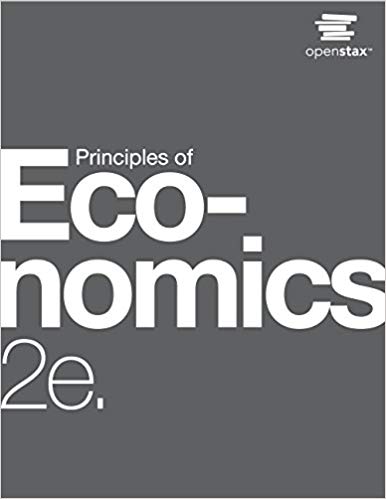
Say that the average worker in Canada has a productivity level of
Want to see the full answer?
Check out a sample textbook solution
Chapter 20 Solutions
Principles of Economics 2e
Additional Business Textbook Solutions
Managerial Accounting (4th Edition)
Principles of Management
Horngren's Accounting (12th Edition)
Principles of Accounting Volume 1
Managerial Accounting (5th Edition)
Principles of Accounting Volume 2
- Say that the average worker in the U.S. economy is eight times as productive as an average worker in Mexico. If the productivity of U.S. workers grows at 2 for 25 years and the productivity of Mexicos workers grows at 6 for 25 years, which country will have higher worker productivity at that point?arrow_forwardAssuming UAE’s 2021 economic growth is projected to be 3.5%. How long will it take to double the size of that economy? Show your calculations.arrow_forwardReal GDP per capita in the country of Arcadia grew from about $4.545 in 1900 to about $40.064 in 2008, which represents an annual growth rate of 2.04 percent IH Arcadia continues to grow at this rate, calculate the number of years when its real GDP per capita will double years. (Enter your response as an integer)arrow_forward
- Downtown has been experiencing an explosive population growth of 10% per year. At the end of 2017 the population was 16,000. If the growth rate continues unabated, how many years will it take the population to triple?arrow_forwardIn this section we looked at the growth rate formula for measuring the average annual growth rate of a variable, such as the CPI, the GDP deflator, or real GDP. It can be used for any two years, which may be years apart. For example, in the worksheet you computed the average annual rate of inflation from 1920 to 2020. If you use the growth rate formula for a variable one year apart, do you get the same value as you do with the percentage change formula? Hint: Say that real GDP grew from $20.0 trillion one year to $20.4 trillion the next year. Do both the percentage change and the growth rate formulas give you the same answer? yes noarrow_forwardAt an annual growth rate of 2% it will take approximately years for a country's GDP to double. Over the next 70 years, how many times will GDP double, assuming the growth rate does not change?arrow_forward
- Suppose Nation B has 8,623 labor hours each year to produce burgers and fries. Burgers take 13 hours to produce each, and fries take 7 hours to produce each. Suppose Nation B also sees a sudden surge in working-age immigrants, leading to 26% higher labor hours each year. What is the maximum number of fries is Nation B able to produce in a year after this surge of immigration? Round your answer to one place after the decimal point (0.1).arrow_forwardA country starts with real GDP per capita of 500, and is growing at 4.3% per year. After 70 years, real GDP per capita will be approximately...?arrow_forwardSay that the average worker in Canada has productivity of $21 per hour while the average worker in Australia has productivity of $33 per hour (both measured in U.S. dollars). If worker productivity, over the next 7 years, grows 3% per year in Canada and 3% in Australia. At the end of the 5 years, how much more productive are Australians workers relative to Canadians, in percentage terms. (Do not include the % sign, round your answer to include 2 decimal places).arrow_forward
- Suppose a country has a population of 120 people, a working-age population of 100 people, its labor force participation rate is 0.5 (50%), and the quantity of output is 60 units. Suppose that the production function of the economy is given by Y=2N, where Y represents the quantity of output and N represents the number of workers needed to produce the output. I know the answer is 0.4 but I don't understand how to get it. Thank you!arrow_forwardAssume real per capita GDP in West Swimsuit is $8,000 while in South Darlinia it is $2,000. The annual growth rate in West Swimsuit is 2.33%, while in South Darlinia it is 7%. How many years will it take for South Darlinia to catch up to the real per capita GDP of West Swimsuit? What will the income of the two countries be when it is equal? solve it correctly please. I will rate accordingly. Ty-ped answer please...arrow_forwardAt an annual growth rate of 2% it will take approximately years for a country's GDP to double. Over the next 70 years, how many times will GDP double, assuming the growth rate does not change? If GDP starts at a value of $10 million, then in 70 years the value of GDP will be $ million. In 70 years the value of GDP will be times larger than it is today.arrow_forward
 Principles of Economics 2eEconomicsISBN:9781947172364Author:Steven A. Greenlaw; David ShapiroPublisher:OpenStax
Principles of Economics 2eEconomicsISBN:9781947172364Author:Steven A. Greenlaw; David ShapiroPublisher:OpenStax

 Microeconomics: Private and Public Choice (MindTa...EconomicsISBN:9781305506893Author:James D. Gwartney, Richard L. Stroup, Russell S. Sobel, David A. MacphersonPublisher:Cengage Learning
Microeconomics: Private and Public Choice (MindTa...EconomicsISBN:9781305506893Author:James D. Gwartney, Richard L. Stroup, Russell S. Sobel, David A. MacphersonPublisher:Cengage Learning Economics: Private and Public Choice (MindTap Cou...EconomicsISBN:9781305506725Author:James D. Gwartney, Richard L. Stroup, Russell S. Sobel, David A. MacphersonPublisher:Cengage Learning
Economics: Private and Public Choice (MindTap Cou...EconomicsISBN:9781305506725Author:James D. Gwartney, Richard L. Stroup, Russell S. Sobel, David A. MacphersonPublisher:Cengage Learning Essentials of Economics (MindTap Course List)EconomicsISBN:9781337091992Author:N. Gregory MankiwPublisher:Cengage Learning
Essentials of Economics (MindTap Course List)EconomicsISBN:9781337091992Author:N. Gregory MankiwPublisher:Cengage Learning





